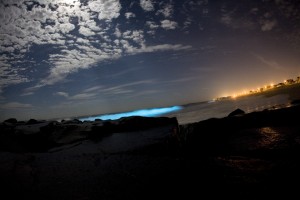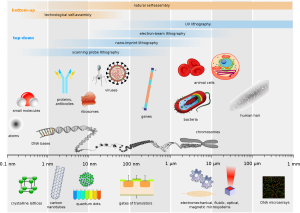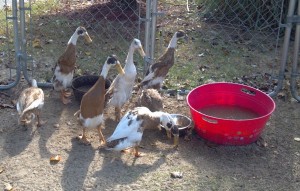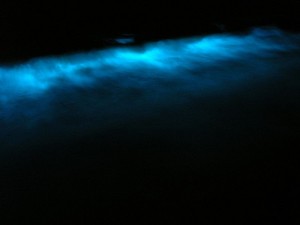Lighting up the Deep Sea
Bioluminescent Beings and Their a Brief Background
Pyrocystis fusiformis will biolumenesce for its own survival. It will start to flash when it gets “scared”, which is pretty much any sudden or harsh movement. When the predators of Pyrocystis fusiformis start to graze on the bioluminescence algae it starts to flash brightly. This action spreads through the algae bloom creating a large mass of light in the middle of the ocean. Scientists have come up with some potential reasons for why this happens. In other words, they have a few theories as to how the bioluminescence gives Pyrocystis fusiformis an evolutionary edge. One such theory is that it helps attract lager predators, the ones that eat other predators, not algae. Essentially eliminating the grazers that eat Pyrocystis fusiformis by calling some bigger badder guys. While this might seem like some sort of brilliant idea, or a well thought out plan, it’s actually a complex process of trial and error. This complexity marks the progress and diversity of evolution. Many species are capable of biolumenescing but each have a unique situation in which they use it, or stimulation that causes the chemicals to glow. Here is a short video to help you understand bioluminescence and the diversity of species who have this feature.
Many sea creatures use bioluminescence as a way to hunt, scare off predators or to gain a mate. The full function is not always clear. Here are three examples of biolumenece in sea creatures along with the function of the bioluminescence.
Flashing for Freedom
Hinea brasiliana is a sea snail that bioluminesces when predators come too close. The flashing lights help warn those around of the danger. While this is an amazing feature in and of its self; the small snail has adapted its shell as well. Scientists Dimitri Deheyn and Nerida Wilson noted the shells ability to disperse the light evenly in all directions. In other words, the whole shell becomes a glowing beacon, emitting light in the most efficient way. This is much more advanced than the previous idea of a single beam that would only signal a few other snails. But with the light being dispersed the way it is; it makes Hinea brasiliana appear larger, warning the rest of the group or cluster. A small group of snails, all lit up like glowing orbs, become a large bright mass that scares off would-be predators. Here you can see Dimitri Deheyn talk about these snails and their special shell.
Damn Baby Those are Some Nice Lights
John Sparks and Matthew Davis have looked at the biolumenecens in the Tarletonbeania crenularis and how the population use the function for mating purposes. These small fish have bioluminescence on both their bellies and on the sides of their bodies. While the sections on their bellies are used as camouflage from predators below, the sides have a different function entirely. The smaller lights that run down the sides of each fish helps them spot potential mates. While the light they produce isn’t visible to most fish (used for camouflage not as a beacon) it is visible to those in the same species. This makes communication through bioluminescent flashes a possibility. John and Matthew are still doing research into these functions. The Hatchet Fish or Argyropelecus hemigymnus is similar to Tarletonbeania crenularis in how it uses bioluminescence for camouflage.
Don’t I Just Look Good Enough to Eat?
Many microorganisms live in the deep sea. Some have evolved to become bioluminescent, in doing so they have increased their chances of being eaten. It is thought that many organisms in the deep sea are photosensitive (sensitive to light) and will be drawn towards anything that glows. Many of these creatures are so interested in the light that they will start trying to eat the source. Being a micro organism creates challenges when it comes to food collection, instead of swimming or propelling oneself, these creatures are left to drift with the currents. By being consumed by a larger creature the micro organisms have a chance to get nutrients from whatever the creature had just eaten before. In a way the micro organisms act like a tapeworm, getting nutrients from the host. Unlike a tapeworm, these micro organisms are quickly passed with the rest of the waste, freeing it to find a new host. Different micro organisms live at different depths and locations, here is a quick video of one of these organisms in action.
Are you hooked? Check out my resources for more information!
• https://www.sciencedaily.com/releases/2010/12/101214201534.htm
• https://www.youtube.com/watch?v=oKjFVBVGad0
• https://www.youtube.com/watch?v=STIOG95c8-E
• https://www.sciencedaily.com/releases/2014/03/140304095107.htm
• https://www.youtube.com/watch?v=XmjflLIB9J4
• https://www.sciencedaily.com/releases/2007/09/070919073007.htm
• https://www.youtube.com/watch?v=rd0z7NIjpBM
• https://microbewiki.kenyon.edu/index.php/Pyrocystis_fusiformis
• http://onlinelibrary.wiley.com/store/10.4319/lo.1976.21.3.0418/asset/lno19762130418.pdf?v=1&t=io0jof29&s=63c80302a00358d93453d9aec91d6ce5eb8d0482&systemMessage=Wiley+Online+Library+will+be+unavailable+on+Saturday+14th+May+11%3A00-14%3A00+BST+%2F+06%3A00-09%3A00+EDT+%2F+18%3A00-21%3A00+SGT+for+essential+maintenance.Apologies+for+the+inconvenience.
•
Raising Pyros or Algal Blooms
Title/ abstract (last to finish as a group)
- Algal Blooms
- Includes the question to be answered by the lab
- Can Pyrocystis fusiformis double its population in 7 days in a lab setting given a constant temperature and light.
- States hypothesis that is based on research and/or sound reasoning
- Given optimum growing conditions the alga content will be a higher concentration than previously observed and the biolumencents will increase. That is to say that when Pyrocystis fusiformis grows in lab conditions, there should be a denser culture after 7 days then at the beginning. With a denser culture there would be more biolumencents in the sample.
- Title is relevant.
- Algal Blooms- P. fusiformis is an algae and algal rapid growth is referred to as a “bloom”
Introduction (sam does intro :3)
- Background information is researched and cited. Hypothesis is stated.
Methods
- Description or step-by-step process is included, could be repeated by another scientist
- step by step process reads like a lab report.
This experiment was inspire by the circadian rhythm in land plants; the opening and closing of leaves and flowers due to the sun. In an effort to tie land to sea we wanted to find an algae that had a circadian rhythm. The algae we found was a tropical species that bioluminesses when stimulated–Pyrocystis fusiformis
Equipment Needed:
what you will need to conduct this experiment
- Light meter
- 150mL beaker
- 100mL beaker
- aluminum foil
- light fixture
- temperature meter
- water bath
- fish tank heater rod
- 1,000 mL small mouth flask
- 50mL P. fusiformis
- pH tabs
- light timer
- black tarp of some-sort
- scotch tape
- two milk crates
- extension cord
- LabQuest
- two pennies
- large (15″x7″x7″) Tupperware container
- zip ties
- hand saw
Set up:
First: You will need to take the two milk crates and saw one side off of each crate using the hand saw.
Second: Tie the crates, sawed off sides together, with the zip ties. make sure the facings are on the same side.
Third: Attach aluminum foil to the crate using tape. Note- make sure to have a solid piece of foil hanging down from the front of the crate. there should be no holes. the crate will be placed with the width down (taller than wider).
Fourth: Tape pennies to the bottom of the tin.
Fifth: Attach the light to the light fixture between the crosses in the milk crate at the top of the crate. so that the light bulb is inside the
Sixth: Place the fish tank heater in the 1,000 mL small mouth flask
Seventh: Place the 1,000 mL small mouth flask into the large (15″x7″x7″) Tupperware container
Eighth: Place the algae in the 100mL beaker, place the thermometer in the beaker, tape the top of the beaker leaving a hole at the lip of the beaker.
Ninth: Fill 150mL beaker half way with water. place the 100mL beaker into the 150mL beaker.
Tenth: Now place the two beakers in the Tupperwear container-fill with water.
Results (Tyler?)
- Data is complete and relevant.
- Spell it out go over as a group to gauge completeness
- Table and graphs are easy to read, are labeled and units are provided.
- Graphs of temperature, growth, bioluminescence, light
- Hypotheses are addressed completely and correctly
- Restate hypothesis and expand based on data
Summary of Experiment
Pyrocystis fusiformis has a unique growth rate just like any other living thing. We wanted to look at this growth rate by growing our own sample of Pyrocystis fusiformis in average conditions. We planned on growing a sample and taking videos every day, then compiling our data into a comprehensible graph/table. The calculations needed are simple; the few Pyrocystis fusiformis that bioluminece in a small area would be multiplied by the ratio of that small area to the rest of the sample. For example, if we looked at half of our 50mL sample and saw 5 Pyrocystis fusiformis light up in a 10 second time period, then we would multiply the five we counted by 2. This would give us 10 Pyrocystis fusiformis in our 50mL sample. More accurately; this would give us the number of Pyrocystis fusiformis that bioluminesces in a 50mL sample over 10 seconds of agitation. To do this we gathered a 50mL sample of Pyrocystis fusiformis and tried to create ideal growing conditions. These conditions include 12 hour cycles of light and dark, continuous temperature (70F) and some nutrients to grow.
Cited Data
Unfortunately we did not gather any data from our sample of Pyrocystis fusiformis. By looking at videos of other samples we have not been able to answer our question about growth rate. I will explain why we didn’t gather data a little further on.
Hypothesis vs. Reality
First we hypothesized that we could calculate the growth rate of Pyrocystis fusiformis using the assumption that a higher concentration would result in more bioluminescence. We planned on taking a video, calculating the flashes seen in one measurable section, and then using that small section to calculate how many Pyrocystis fusiformis are in the container in total. There is no reason to believe that an population sample would not accurately calculate the total amount of Pyrocystis fusiformis in a sample, but our sample never grew. Without a properly grown algae sample, we weren’t able to film videos. Without multiple videos to examine, we weren’t able to prove or disprove our hypothesis.
Errors we Made for You
During our experiment we encountered the challenge of keeping Pyrocystis fusiformis at the appropriate growing temperature. At first we kept the sample of Pyrocystis fusiformis in a hot water bath. Despite the growing temperature being 18C-22C (about room temperature) the room we had access to for our experiment was 16C-17C. We had to increase the temperature to successfully grow our sample of Pyrocystis fusiformis. The first set up was a simple hot water heater with a basin filled with water; then a smaller beaker set inside with our sample inside. The lowest setting of the heating instrument was too hot for the algae. Next we changed to a small circular flask (100mL) with a heating cozy around it. This was also too warm. Finally we got a large tank heater. We placed this tank heater into a deep beaker (a) filled with water. This large beaker (with heater inside) is placed in a large plastic dish that we filled with water and set a smaller beaker (b) in. The plastic dish filled with water now holds the tank heater/beaker (a) on one side and the other beaker (b) on the other side. Beaker (b) is full of water, and has a smaller beaker (c) floating in its water. The beaker (c) has the sample of Pyrocystis fusiformis inside it with a thermometer recording its temperature.
Unlike in the ocean, the sample of Pyrocystis fusiformis was stuck in the temperatures we set for it. When it was too cold they had to become dormant; while over-heating essentially cooks them. Our sample was subject to a flux of both too much and too little heat, which is why it wasn’t able to grow properly. The final set up where the temperature is regulated by a tank heater, capable of increasing or decreasing temperature by a degree (F), gives the most control over the heat. With the hot water bath the temperature is more steady and regulated. Unfortunately for us we found this out just a little too late.
References (As a group)
- References cited according to journal standards
- Cite all work easy bib
Quality
- Report is follows given guidelines
- Cohesive
- One or fewer grammatical or spelling errors.
Group Project Progress Summary
Our group project started out with us wanting to experiment with the circadian rhythm of P. fusiformis our experiment objective was to see if the amount of light/dark ratio had an effect on the of bioluminescence. The usual light/dark ratio of P. fusifromus is 1/1; that is 12 hours of light with 12 of dark. Deciding to exposing the P. fusiformus to light/dark three different ways; 6 hours of light fallowed by 6 of dark, 12 hours of light with 12 hours of dark, and 24 hours of light with 24 hours of darkness. Keeping the basic 1/1 ration but with different frequencies. By changing the length of time P. fusiformus is exposed to light/dark we anticipated the growth rate and bioluminescence properties to change. We thought that by changing the frequency by 2 and .5 would show us over stimulation and under stimulated. That is there 24 hour cycle would possibly over work the bioluminescence of P. fusiformis while the 6 hour cycle might not give enough stimulation for the algae to biolumines. These are based on what we see happen to land plants, however the algae could act differently. For example, P. fusiformis could be capable of re-aranging itself to self-regulate its light/dark cycles. If P. fusiformis is capable of this movement that would aid in light absorption and prevent overexposure. We know that P. fusiformis hasn’t had to develop like land plants, so how it reacts to light cycles is probably different. For our experiment we need three tanks that are temperature regulated, grow lights on timers (with the right light waves for the growth/bioluminesence of P. fusiformis.) along with black out screens to prevent light during the dark section of the cycle. To examine this function we need lots of equipment; thermometer, light sensor, co2 meter, ph strips, saline solution, nitrogen and phosphorous. Unfortunately we do not have access to a good enough light sensor to complete this experiment. The blue bioluminescence that P. fusiformis produces is too dim for the light sensor to read. This is especially true if we were to try to record the process with any sort of camera. The light a camera needs to produce a picture would drown out the light the P. fusiformis can produce.Our group project started out with us wanting to experiment with the circadian rhythm of P. fusiformis our experiment objective was to see if the amount of light/dark ratio had an effect on the bioluminescence.
Methods:
what you will need to conduct this experiment
- Light meter
- 150mL beaker
- 100mL beaker
- aluminum foil
- light fixture
- temperature meter
- water bath
- fish tank heater rod
- 1,000 mL small mouth flask
- 50mL P. fusiformis
- pH tabs
- light timer
- black tarp of some-sort
- scotch tape
- two milk crates
- extension cord
- LabQuest
- two pennies
- large (15″x7″x7″) Tupperware container
Our goal for this experiment is to cause the algae (P. fusiformis) to bioluminess from motion we cause. i.e. stirring of the solution. From this reaction we will use video analysis to calculate the population of P. fusiformis through out our experiment.
So far we have set up the experiment and accommodated the algae. Currently we are trying to create a regulated temperature of 24 degrees Celsius to maintain the algae; they can withstand a temperature range from 22C-28C.
Abstract
Our group project started out with us wanting to experiment with the circadian rhythm of P. fusiformis our experiment objective was to see if the amount of light/dark ratio had an effect on the of bioluminescence. The usual light/dark ratio of P. fusifromus is 1/1; that is 12 hours of light with 12 of dark. Deciding to exposing the P. fusiformus to light/dark three different ways; 6 hours of light fallowed by 6 of dark, 12 hours of light with 12 hours of dark, and 24 hours of light with 24 hours of darkness. Keeping the basic 1/1 ration but with different frequencies. By changing the length of time P. fusiformus is exposed to light/dark we anticipated the growth rate and bioluminescence properties to change. We thought that by changing the frequency by 2 and .5 would show us over stimulation and under stimulated. That is there 24 hour cycle would possibly over work the bioluminescence of P. fusiformis while the 6 hour cycle might not give enough stimulation for the algae to biolumines. These are based on what we see happen to land plants, however the algae could act differently. For example, P. fusiformis could be capable of re-aranging itself to self-regulate its light/dark cycles. If P. fusiformis is capable of this movement that would aid in light absorption and prevent overexposure. We know that P. fusiformis hasn’t had to develop like land plants, so how it reacts to light cycles is probably different. For our experiment we need three tanks that are temperature regulated, grow lights on timers (with the right light waves for the growth/bioluminesence of P. fusiformis.) along with black out screens to prevent light during the dark section of the cycle. To examine this function we need lots of equipment; thermometer, light sensor, co2 meter, ph strips, saline solution, nitrogen and phosphorous. Unfortunately we do not have access to a good enough light sensor to complete this experiment. The blue bioluminescence that P. fusiformis produces is too dim for the light sensor to read. This is especially true if we were to try to record the process with any sort of camera. The light a camera needs to produce a picture would drown out the light the P. fusiformis can produce.
The Glowing Sea
One of Earth’s Many Wonders
 Many have not had the chance to witness this great feat of Mother Nature in person, some don’t even believe it’s real. Many watched movies with beautiful glowing seas depicting mystical phenomenons that “just couldn’t be” part of real life. Well… Mother Nature truly is mystical and has come up with these beautiful displays of light called bioluminescence. In fact, nature has many different plants and animals that have bioluminescent capabilities appearing in her skies, lands and vast oceans. In this report I will be focusing on one of the smallest imaginable–Pyrocystis fusiformis
Many have not had the chance to witness this great feat of Mother Nature in person, some don’t even believe it’s real. Many watched movies with beautiful glowing seas depicting mystical phenomenons that “just couldn’t be” part of real life. Well… Mother Nature truly is mystical and has come up with these beautiful displays of light called bioluminescence. In fact, nature has many different plants and animals that have bioluminescent capabilities appearing in her skies, lands and vast oceans. In this report I will be focusing on one of the smallest imaginable–Pyrocystis fusiformis

P. fusiformis is a unicellular eukaryotic algae that is smaller than an ant! P. fusiformis can be identify by its elongated fusiform shaped body and tapered ends. It has an average length and width of 970 x 163 µm with the equivalent spherical diameter being 374 µm. To put their size in perspective an average human egg cell is approximately 1mm in size, which is 1,000 times bigger than a single micrometer (µm).
Here’s a link to a video of P. fusiformis being stimulated.
https://www.youtube.com/watch?v=UshqKYMdEfo
This stimulation is caused when the flask moves in circular motions agitating the water. This specific type of alga can be seen reacting to stimulation produced by the wakes of ships, swimming animals, in breaking surface waves, or from predator movement; the reaction is bioluminescence. Amazingly P. fusiformis can produce approximately 23-62 flashes per second, lasting 210 milliseconds, with a maximum photon intensity of 690 x 109 photons per second (these values are approximations for only the first flash).
CIRCADIAN RHYTHM Ooo…. what is it?
Circadian rhythm is a twelve hour light to twelve hour dark period of time. Circadian rhythm has played a role in many organisms life stages, reproduction processes, and eating habits. Particularly for this algae, the circadian rhythm plays a part in the transition from stage one to two and stage two, to three of their life cycle. More over, this process can also occur in a twenty-four hour dark period due to the amount of stored starches in this organism. There are 6 stages to their life cycle, and when placed in a dark place for an excess of 24 hours, the amount of various stage changes showing more 1,2,3, and 4 stages, where stage 5 and 6 are now not existent. This means that the 5th and 6th life stage requires light to occur.
Still with me? I know that was a lot to take in.

Here’s some ducks.
Back to the cute algae that we’re so interested in !
Cool fact about P. fusiformis is that at night (dark cycle) the chloroplasts(pigment) all move to the center of the cell surrounding the nucleus. It moves as much as 400 to 450 um twice each day. This changes the appearance of the specimen so that every night stage has a corresponding light stage, if the stage lasts more than twelve hours. -they’re shape shifters-
So, why did you read all of this? To further your knowledge of the amazing place we call home!? To one up your friend at a party? What ever your reasoning you will now have a greater understanding of our ocean and some of the critters in it! Most importantly you know what actually causes the glowing oceans; what first peaked your interest.
- https://microbewiki.kenyon.edu/index.php/Pyrocystis_fusiformis
- https://www.youtube.com/watch?v=UshqKYMdEfo
- https://www.youtube.com/watch?v=kEd6AYWK9uQ
- https://www.youtube.com/watch?v=kNhTba6t-Lo
- https://exploringtheinvisible.com/2013/11/21/c-mould-new-acquisition-pyrocystis-fusiformis/
- https://www.sciencedaily.com/terms/circadian_rhythm.htm
- Latz, Michael I., Jennifer C. Nauen, and Jim Rohr. “Bioluminescence response of four species of dinoflagellates to fully developed pipe flow.” Journal of Plankton Research 26 (2004): 1529-546.
- Latz, Michael I., Michelle Bovard, Virginia Van Delinder, Enrico Segre, Jim Rohr, and Alex Groisman. “Bioluminescent response of individual dinoflagellate cells to hydrodynamic stress measured with millisecond resolution in a microfluidic device.” The Journal of Experimental Biology 211 (2008): 2865-875.
- Foflonker, Fatima, and John Cowan. “Pyrocystis Fusiformis.”Https://microbewiki.kenyon.edu. Prof. Jay Lennon, 25 Aug. 2010. Web. 6 Mar. 2016.
- Sweeney, B. M. “Interaction of the Circadian Cycle with the Cell Cycle in Pyrocystis Fusiformis.” Plant Physiology 70.1 (1982): 272-76. Web.
- Swift, Elijah, Marc Stuart, and Valerie Meunier. “The in Situ Growth Rates of Some Deep-living Oceanic Dinoflagellates: Pyrocystis Fusiformis and Pyrocystis Noctiluca.” Limnol. Oceangr. Limnology and Oceanography21.3 (1976): 418-26. Web.
Samantha A’s blog post
Bioluminescent Algae and Adaptation
A few spots in the world, such as Cairns Australia, are home to a marvelous sight that only shows itself once in a great while. Much like a flower blooming and staying hidden out of sight there are a few species of saltwater algae that bloom into beauty. Bioluminescent Algae such as Pyrocystis fusiformis, reacts to motion with a brilliant display of blue green light, seen in the image to the right.
This rather amazing act is one I plan on looking into for an extended period of time, starting with there growth cycle and how particular they are to temperature change. My goal will be to gain the data that I need in order to form a solid starting point to perform new research into algae adaptation and possibly forced evolution.
 Comments(0)
Comments(0)